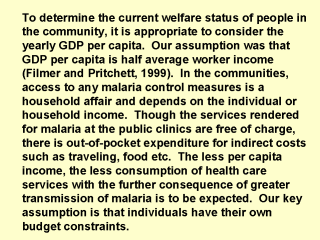 |
Thus a strategy for socio-economic development is
desirable and will be significant for changes in the magnitude of malaria in Myanmar. The
less GDP per capita relating to the higher incidence of malaria in our study is also
explained indirectly. Malaria is a disease of socioeconomic relevance. If health is a
consumption commodity (Grossman, 1972), then family and national economy may be negatively
affected by the occurrence of malaria. If health is an investment commodity (Grossman,
1972), then a lower GDP may contribute to diminishing resources-dependent malaria control
activities. Put otherwise, malaria- poverty-malaria is recognizable as an economic vicious
cycle (Murti, 1998), but which comes first could not be explained from our study. The
causality is of course two-sided (McCarthy et al, 1999). |
